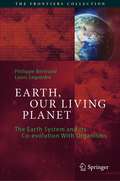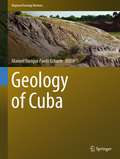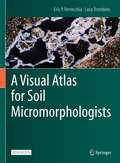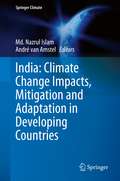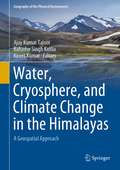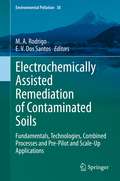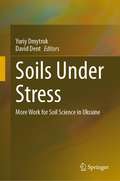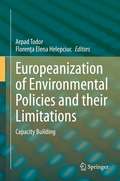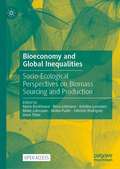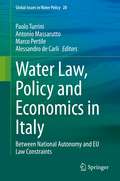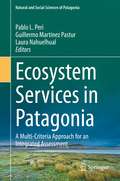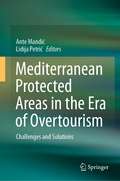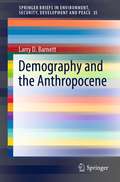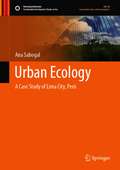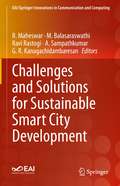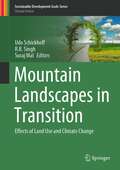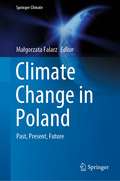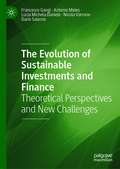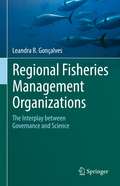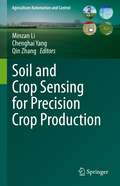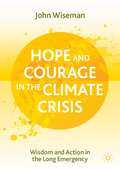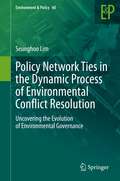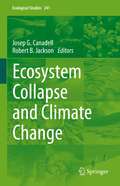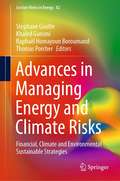- Table View
- List View
Earth, Our Living Planet: The Earth System and its Co-evolution With Organisms (The Frontiers Collection)
by Philippe Bertrand Louis LegendreEarth is, to our knowledge, the only life-bearing body in the Solar System. This extraordinary characteristic dates back almost 4 billion years. How to explain that Earth is teeming with organisms and that this has lasted for so long? What makes Earth different from its sister planets Mars and Venus? The habitability of a planet is its capacity to allow the emergence of organisms. What astronomical and geological conditions concurred to make Earth habitable 4 billion years ago, and how has it remained habitable since? What have been the respective roles of non-biological and biological characteristics in maintaining the habitability of Earth? This unique book answers the above questions by considering the roles of organisms and ecosystems in the Earth System, which is made of the non-living and living components of the planet. Organisms have progressively occupied all the habitats of the planet, diversifying into countless life forms and developing enormous biomasses over the past 3.6 billion years. In this way, organisms and ecosystems "took over" the Earth System, and thus became major agents in its regulation and global evolution. There was co-evolution of the different components of the Earth System, leading to a number of feedback mechanisms that regulated long-term Earth conditions. For millennia, and especially since the Industrial Revolution nearly 300 years ago, humans have gradually transformed the Earth System. Technological developments combined with the large increase in human population have led, in recent decades, to major changes in the Earth's climate, soils, biodiversity and quality of air and water. After some successes in the 20th century at preventing internationally environmental disasters, human societies are now facing major challenges arising from climate change. Some of these challenges are short-term and others concern the thousand-year evolution of the Earth's climate. Humans should become the stewards of Earth.
Geology of Cuba (Regional Geology Reviews)
by Manuel Enrique Pardo EcharteThe evolution of geological cartography in Cuba in its more than 135 years of history has been possible through the consultation of numerous archival reports, publications, maps and personal interviews with different authors and geologists of vast experience. A brief critical analysis is made of the increase in the degree of geological knowledge of the country since the elaboration of the Geological Sketch of the Cuban Island at a scale of 1: 2 000 000 (Fernández de Castro, 1883), first of Cuba and of Ibero-America, until the most recent Digital Geological Map of Cuba at scale 1: 100 000 (Pérez Aragón, 2016). Cuba and its surroundings are a geological mosaic in the southeast corner of the North American plate with rocks from many different origins, from Proterozoic to Quaternary, extended along the southern border of the plate. From the Eocene, this belt has been dissected by several great faults, related to the development of some great oceanic depressions (Cayman trough and Yucatan basin). The fossil record of Cuba, which covers approximately the last 200 million years of life on Earth, is rich in very varied fossils, witnessing a wide diversity of organisms, both animals and plants, that inhabited the Antillean and Caribbean region; and that constitute the inheritance of the biological diversity that the current Cuban archipelago exhibits. As a result of the preparation of the Cuban Metallogenic Map at scale 1: 250 000, forty-one models and eight sub-models of metallic mineral deposits were identified. These models, of descriptive–genetic type, together with the analysis of their spatial distribution and their relationship with geology, allowed the identification and mapping of ten mineral systems, linked to the geodynamic environments present in the Cuban territory. Cuba has large deposits of limestone, loam, dolomite, kaolin, gypsum and anhydrite, rock salt, marbles, sands and clays of different types, zeolites, peat, therapeutic peloids and many more. There are manifestations of decorative and precious rocks such as jasper, jadeite, different varieties of quartz and even xylopals. A compilation of geochemical data of oceanic basalt samples from previous works, together with data of analyzed samples during this study in order to discuss geochemical criteria based on immobile element (proxies for fractionation indices, alkalinity, mantle flow and subduction addition), provide a comprehensive ophiolite classification according to their tectonic setting. This book addresses different facets of the geological knowledge of Cuba: history of its cartography, marine geology, fossil record, stratigraphy, tectonics, classification of its ophiolites, quaternary deposits, metallogeny and minerageny.
A Visual Atlas for Soil Micromorphologists
by Eric P. Verrecchia Luca TrombinoThis open access atlas is an up-to-date visual resource on the features and structures observed in soil thin sections, i.e. soil micromorphology. The book addresses the growing interest in soil micromorphology in the fields of soil science, earth science, archaeology and forensic science, and serves as a reference tool for researchers and students for fast learning and intuitive feature and structure recognition. The book is divided into six parts and contains hundreds of images and photomicrographs. Part one is devoted to the way to sample properly soils, the method of preparation of thin sections, the main tool of soil micromorphology (the microscope), and the approach of soil micromorphology as a scientific method. Part two focuses on the organisation of soil fragments and presents the concept of fabric. Part three addresses the basic components, e.g. rocks, minerals, organic compounds and anthropogenic features. Part four lists all the various types of pedogenic features observed in a soil, i.e. the imprint of pedogenesis. Part five gives interpretations of features associated with the main processes at work in soils and paleosols. Part six presents a view of what the future of soil micromorphology could be. Finally, the last part consists of the index and annexes, including the list of mineral formulas. This atlas will be of interest to researchers, academics, and students, who will find it a convenient tool for the self-teaching of soil micromorphology by using comparative photographs.
India: Climate Change Impacts, Mitigation and Adaptation in Developing Countries (Springer Climate)
by Md. Nazrul Islam André Van AmstelClimate change will lead to many changes in global development and security especially energy, water, food, society, job, diplomacy, culture, economy and trade. The Intergovernmental Panel on Climate Change (IPCC) defines climate change as: “Any change in climate over time, whether due to natural variability or as a result of human activity.” Global climate change has emerged as a key issue in both political and economic arenas. It is an increasingly questioned phenomenon, and progressive national governments around the world have started taking action to respond to these environmental concerns. This book discusses the issue of food and water security in India under the context of climate change. It provides information to scientists and local government to help them better understand the particularities of the local climate. It offers insight into the changes to natural ecosystems which have affected the local Indian population. Climate change is one of the biggest challenges to Indian society. It can lead to serious impacts on production, life and the environment. Higher temperatures and sea level rise can lead to flooding and cause water salinity problems which bring about negative effects on agriculture and high risks to industry and socio-economic systems in the future.
Water, Cryosphere, and Climate Change in the Himalayas: A Geospatial Approach (Geography of the Physical Environment)
by Kireet Kumar Ajay Kumar Taloor Bahadur Singh KotliaThis edited book summarizes numerous research studies on remote sensing and GIS of natural resource management for the Himalaya region done by Indian Institutions and Universities over the last decade. It gives an overview of hydrometeorological studies on Himalayan water resources and addresses concerns in the development of water resources in this region, which is dealing with an increased pressure in population, industrialization and economic development. While the source of some of the major rivers of India are found in the Himalayas, the glaciers and water bodies in the region are continuously shrinking leading to a depletion of water and deterioration of water quality. This is affecting a population of up to 2.5 billion people. The ecosystems have been under threat due to deforestation, loss of biodiversity, expansion of agriculture and settlement, overexploitation of natural resources, habitat loss and fragmentation, poaching, mining, construction of roads and large dams, and unplanned tourism. Spaceborne remote sensing with its ability to provide synoptic and repetitive coverage has emerged as a powerful tool for assessment and monitoring of the Himalayan resources and phenomena. This work serves as a resource to students, researchers, scientists, professionals, and policy makers both in India and on a global level.
Electrochemically Assisted Remediation of Contaminated Soils: Fundamentals, Technologies, Combined Processes and Pre-Pilot and Scale-Up Applications (Environmental Pollution #30)
by M. A. Rodrigo E. V. Dos SantosThis book provides an overview of the current development status of remediation technologies involving electrochemical processes, which are used to clean up soils that are contaminated with different types of contaminants (organics, inorganics, metalloids and radioactive). Written by internationally recognized experts, it comprises 21 chapters describing the characteristics and theoretical foundations of various electrochemical applications of soil remediation. The book’s opening section discusses the fundamental properties and characteristics of the soil, which are essential to understand the processes that can most effectively remove organic and inorganic compounds. This part also focuses on the primary processes that contribute to the application of electrochemically assisted remediation, hydrodynamic aspects and kinetics of contaminants in the soil. It also reviews the techniques that have been developed for the treatment of contaminated soils using electrochemistry, and discusses different strategies used to enhance performance, the type of electrode and electrolyte, and the most important operating conditions. In turn, the book’s second part deals with practical applications of technologies related to the separation of pollutants from soil. Special emphasis is given to the characteristics of these technologies regarding transport of the contaminants and soil toxicity after treatment. The third part is dedicated to new technologies, including electrokinetic remediation and hybrid approaches, for the treatment of emerging contaminants by ex-situ and in-situ production of strong oxidant species used for soil remediation. It also discusses pre-pilot scale for soil treatment and the use of solar photovoltaic panels as an energy source for powering electrochemical systems, which can reduce both the investment and maintenance costs of electrochemically assisted processes.
Soils Under Stress: More Work for Soil Science in Ukraine
by David Dent Yuriy DmytrukDokuchaev carried out most of his research in Ukraine. His student and friend, Volodymyr Vernadsky, went on to create trans-disciplinary environmental sciences and the concept of Earth as a living organism, famously taken up by James Lovelock. That spring of ideas still flows and the researches captured in this volume are relevant to present-day problems, and not only in Ukraine.Soils have always been under stress but, in the Anthropocene, mankind is in the driving seat. As a sequel to Soil Science Working for a Living: Applications of soil science to present-day problems, we consider issues of policy as well as soil genesis, attributes and functions in various environments, natural and man-made. We consider human impacts on the soil cover through its use and misuse, highlight methods of research and assessment of soil quality, and the threats of soil degradation. The distinguished contributors also describe and propose various options for evaluation and remediation of degraded soils, drawing on the latest methods of modelling and cartography as well as long-term field experiments and long experience.The book will be invaluable to researchers and practitioners in soil science including graduate and post-graduate education, academics and professionals.
Europeanization of Environmental Policies and their Limitations: Capacity Building
by Arpad Todor Florenţa Elena HelepciucThis book offers a window into the mechanisms that drive events when countries with poor track records in environmental protection and low administrative capacity, join an organisation with ambitious environmental regulatory regimes, which include some of the highest environmental protections standards in the world.This book examines the institutional building capacity in Romania after two decades of the development of the EU's environmental policy on elaboration, transposition, implementation, monitoring and institutional building. The book examines how Romania has fared as one of the least environmentally friendly EU member states, and poses the following questions. What are the limits of Europeanisation in the area of public policies? What is the reason why, despite the overwhelming public interest in environmental issues, and widespread agreement that urgent action to protect the environment and prevent catastrophic climate change are paramount, the pace of achieving the goals is remains slow. Why do policies fail?This book brings together several case studies focusing on the evolution of environmental policies in Romania over the last twenty years, with a special focus on the post-accession period (2007 onwards). The book provides an analysis of policies, where progress is less than satisfactory, and examines why this is the case.
Bioeconomy and Global Inequalities: Socio-Ecological Perspectives on Biomass Sourcing and Production
by Rosa Lehmann Anne Tittor Maria Backhouse Kristina Lorenzen Malte Lühmann Janina Puder Fabricio RodríguezThis open access book focuses on the meanings, agendas, as well as the local and global implications of bioeconomy and bioenergy policies in and across South America, Asia and Europe. It explores how a transition away from a fossil and towards a bio-based economic order alters, reinforces and challenges socio-ecological inequalities. The volume presents a historically informed and empirically rich discussion of bioeconomy developments with a particular focus on bio-based energy. A series of conceptual discussions and case studies with a multidisciplinary background in the social sciences illuminate how the deployment of biomass sources from the agricultural and forestry sectors affect societal changes concerning knowledge production, land and labour relations, political participation and international trade. How can a global perspective on socio-ecological inequalities contribute to a complex and critical understanding of bioeconomy? Who participates in the negotiation of specific bioeconomy policies and who does not? Who determines the agenda? To what extent does the bioeconomy affect existing socio-ecological inequalities in rural areas? What are the implications of the bioeconomy for existing relations of extraction and inequalities across regions? The volume is an invitation to reflect upon these questions and more, at a time when the need for an ecological and socially just transition away from a carbon intensive economy is becoming increasingly pressing.
Water Law, Policy and Economics in Italy: Between National Autonomy and EU Law Constraints (Global Issues in Water Policy #28)
by Marco Pertile Paolo Turrini Antonio Massarutto Alessandro De CarliThis book provides the first comprehensive overview of the most important water-related issues that centre on Italy, analysed from several disciplinary perspectives – such as hydrology, economics, law, sociology, environmental sciences and policy studies – in order to promote full understanding of the challenges the country is facing and the ways it could best tackle them.Despite the misconception that Italy is a water-scarce country, is in fact quite rich in water resources. Such resources, however, are unevenly distributed over the Italian territory. Italy’s northern regions rely on quite an abundant quantity of freshwater, whereas in the southern area water endowment is limited. Moreover, climatic differences between North and South contribute to widen the divide. This disparity has notable consequences of socio-economic character, some of which, in turn, feed back into the environmental conditions of Italian regions: pollution, floods, landslides and droughts are among the problems affecting the country. There are numerous features of water use and consumption that distinguish Italy from other comparable countries, such as the significant role played by agriculture (a water-intensive activity), a lead position in the consumption of bottled water, lower-than-average prices of water and a far-from-optimal efficiency of waterworks. All such aspects, and many others, make Italy an essential case study.
Ecosystem Services in Patagonia: A Multi-Criteria Approach for an Integrated Assessment (Natural and Social Sciences of Patagonia)
by Guillermo Martínez Pastur Pablo L. Peri Laura NahuelhualThis book aims to quantify and discuss how societies have directly and indirectly benefited from ecosystem services in Patagonia; not only in terms of provisioning and cultural services, but also regulating and supporting services. Patagonia, a region that stretches across two countries (ca. 10% in Chile and 90% in Argentina), is home to some of the most extensive wilderness areas on our planet. Natural grasslands comprise almost 30% of the Americas, including the Patagonian steppe, while Patagonian southern temperate forests are important for carbon sequestration and storage, play a pivotal role in water regulation, and have become widely recognized for their ecotourism value. However, profound changes are now underway that could affect key ecosystem functions and ultimately human well-being. In this context, one major challenge we face in Patagonia is that ecosystem services are often ignored in economic markets, government policies and land management practices. The book explores the synergies and trade-offs between conservation and economic development as natural landscapes and seascapes continue to degrade in Patagonia. Historically, economic markets have largely focused on the provisioning services (forest products, livestock) while neglecting the interdependent roles of regulating services (erosion and climate control), supporting services (nutrient cycling) and cultural services (recreation, local identity, tourism). Therefore, the present work focuses on ecosystem functions and ecosystem services, as well as on trends in biodiversity and the interactions between natural environments and land-use activities throughout Patagonia.
Mediterranean Protected Areas in the Era of Overtourism: Challenges and Solutions
by Ante Mandić Lidija PetrićThis book comprises studies that reflect on various influences of excessive tourism development in protected areas, and solutions designed and initiated to mitigate such challenges. A large proportion of tourism in Mediterranean destinations constitutes nature-based tourism, in particular, tourism in parks and protected areas. As a destination experiences higher intensity and density of tourism, the potential conflict between maintaining a healthy natural environment and economic development also increases. This has urged planners and decision-makers to devise and adopt innovative approaches that seek to strike a balance between tourism development and nature conservation. This book demonstrates the importance of collaboration across and beyond disciplines and of all groups of stakeholders for maximization of societal impacts and tourism-related benefits.
Demography and the Anthropocene (SpringerBriefs in Environment, Security, Development and Peace #35)
by Larry D. BarnettEnvironmentalists devote little attention at the moment to the size and growth of the human population. To counter this neglect, the monograph (i) includes original graphs showing population size and growth since 1920 in the world as a whole and the United States; (ii) assembles evidence tying the increasing number of people to ecosystem deterioration and its societal consequences; and (iii) analyzes sample-survey data to ascertain whether the current disregard of population pressures by U.S. environmentalists reflects the thinking of Americans generally. However, even if a nation took steps primarily intended to lower childbearing and immigration, the findings of social science research indicate that the steps would not have a substantial, lasting impact. The discussion, which suggests an indirect way by which government may reduce fertility, underlines for environmental scholars the importance of studying their subject in a multidisciplinary, collaborative setting.
Urban Ecology: A Case Study of Lima City, Perú (Sustainable Development Goals Series)
by Ana SabogalThis book emphasizes the necessity of green spaces and landscape planning to achieve a liveable city. It will more specifically enquire on how to reach a better liveability from the current conditions of Lima. This book takes on the one hand classic concepts from urban agronomy as are soil, water and plants, and on the other hand emphasizes the resources, the plant adaptations and the urban ecosystems, according to the context of Lima. Comparisons are also made to landscape concepts from other cities of the word, contemporary methods of urban landscape research are explained in perspectives of agronomy and ecology. The ecological restoration of some natural spaces of Lima are proposed and related to the food security which impacts on the sustainability of the city. Finally, it describes representative Parks of Lima and previous research projects that have allowed to improve the urban landscape. Considering the city's cultural diversity, comparisons to the mountain and rainforest areas are also made.
Challenges and Solutions for Sustainable Smart City Development (EAI/Springer Innovations in Communication and Computing)
by R. Maheswar G. R. Kanagachidambaresan M. Balasaraswathi Ravi Rastogi A. SampathkumarThis book discusses advances in smart and sustainable development of smart environments. The authors discuss the challenges faced in developing sustainable smart applications and provide potential solutions. The solutions are aimed at improving reliability and security with the goal of affordability, safety, and durability. Topics include health care applications, sustainable smart transportation systems, intelligent sustainable wearable electronics, and sustainable smart building and alert systems. Authors are from both industry and academia and present research from around the world.Addresses problems and solutions for sustainable development of smart cities;Includes applications such as healthcare, transportation, wearables, security, and more;Relevant for scientist and researchers working on real time smart city development.
Mountain Landscapes in Transition: Effects of Land Use and Climate Change (Sustainable Development Goals Series)
by R. B. Singh Udo Schickhoff Suraj MalThis book compiles available knowledge of the response of mountain ecosystems to recent climate and land use change and intends to bridge the gap between science, policy and the community concerned. The chapters present key concepts, major drivers and key processes of mountain response, providing transdisciplinary orientation to mountain studies incorporating experiences of academics, community leaders and policy-makers from developed and less developed countries. The book chapters are arranged in two sections. The first section concerns the response processes of mountain environments to climate change. This section addresses climate change itself (past, current and future changes of temperature and precipitation) and its impacts on the cryosphere, hydrosphere, biosphere, and human-environment systems. The second section focuses on the response processes of mountain environments to land use/land cover change. The case studies address effects of changing agriculture and pastoralism, forest/water resources management and urbanization processes, landscape management, and biodiversity conservation. The book is designed as an interdisciplinary publication which critically evaluates developments in mountains of the world with contributions from both social and natural sciences.
Climate Change in Poland: Past, Present, Future (Springer Climate)
by Małgorzata FalarzThis edited book provides a comprehensive overview of the past, present and future climate development in Poland. The book consists of three main parts. The first part presents the results of the study of climate change before instrumental measurements in Poland in the last millennium. The second part analyses the long-term changes and variability of 36 climate characteristics for 14 climate elements, indices, meteorological phenomena and weather types using data from 79 weather stations in the base period 1951–2018 and for long series up to 239 years (1780–2018). The particular attention is paid to climate extremes. The third part of the book deals with projected changes in temperature, precipitation and thermal indices related to the agriculture and energy sectors. Two future time horizons are carried out: 1) near future: 2021–2050 and 2) far future: 2071–2100. The results for Poland are compared to those from Europe and other parts of the world.The book is addressed to scientists (climatologists, geographers, etc.), academic teachers, students, journalists and all those interested in Poland and climate change in Poland.
The Evolution of Sustainable Investments and Finance: Theoretical Perspectives and New Challenges
by Lucia Michela Daniele Francesco Gangi Antonio Meles Nicola Varrone Dario SalernoOver the last decade, socially responsible investments (SRIs) have become paramount to both professionals and academics. In the aftermath of the financial crisis of 2007-8, practitioners have become much more involved in new financial models that integrate returns and positive social and environmental impacts. The authors argue that previous irresponsible financial models are anachronistic, and propose a new relationship between stakeholder and shareholder. Starting from the mainstreaming of SRI, this book recovers the social function of banks and the innovative role of crowdfunding and venture capital models. The book offers a unified perspective for firm and funder, making it a timely and invaluable read for scholars and practitioners interested in sustainable development and social impact finance.
Regional Fisheries Management Organizations: The interplay between governance and science
by Leandra R. GonçalvesThis book analyzes empirical data from three specific Regional Fisheries Management Organizations (RFMOs) designed to establish rules for the conservation and management of fish stocks in the ocean, in order to assess their effectiveness in converting science into policy for the recovery and maintenance of fishery populations. The three RFMOs discussed are the CCAMLR (Convention for the Conservation of Antarctic Marine Living Resources), the ICCAT (International Commission for the Conservation of Atlantic Tunas) and the CCSBT (Commission for the Conservation of Southern Bluefin Tuna). The book seeks to understand when governments choose to listen to science, and establishes a framework to examine the institutional designs currently in place to accommodate RFMO policy suggestions and the conditions under which they are implemented successfully. The study will be of interest to academics and professionals broadly interested in global environmental governance and international relations, and will specifically appeal to policymakers, conservationists, and environmental researchers interested in fishery management and policy at the global and regional scale. Gonçalves provides an accessible and comprehensive analysis of RMFOs. She offers valuable insights into the role of science and politics in shaping sustainable fisheries policies for the open oceans. ---Peter M Haas, Professor Department of Political Science, University of Massachusetts AmherstAs envisaged by the UN Decade of Ocean proclamation, this book is an important and sincere effort, hopefully to be accompanied by many others to come during this promising decade, that will help to build a common framework to ensure that ocean science can support countries and the international community in creating improved conditions for the sustainable development of our cherished Ocean.---Fabio H. Hazin - Professor at Federal Rural University of Pernambuco, Brazil
Soil and Crop Sensing for Precision Crop Production (Agriculture Automation and Control)
by Qin Zhang Minzan Li Chenghai YangSoil and crop sensing is a fundamental component and the first important step in precision agriculture. Unless the level of soil and crop variability is known, appropriate management decisions cannot be made and implemented. In the last few decades, various ground-based sensors have been developed to measure spatial variability in soil properties and nutrients, crop growth and yield, and pest conditions. Remote sensing as an important data collection tool has been increasingly used to map soil and crop growth variability as spatial, spectral and temporal resolutions of image data have improved significantly in recent years. While identifying spatial variability of soil and crop growth within fields is an important first step towards precision management, using that variability to formulate variable rate application plans of farming inputs such as fertilizers and pesticides is another essential step in precision agriculture.The purpose of this book is to present the historical, current and future developments of soil and crop sensing technologies with fundamentals and practical examples. The first chapter gives an overview of soil and crop sensing technologies for precision crop production. The next six chapters provide details on theories, methods, practical applications, as well as challenges and future research needs for all aspects of soil and crop sensing. The last two chapters show how soil and crop sensing technologies can be used for plant phenotyping and precision fertilization. The chapters are written by some of the world’s leading experts who have contributed significantly to the developments of precision agriculture technologies, especially in the area of soil and crop sensing. They use their knowledge, experiences, and successful stories to present informative and up-to-date information on relevant topics. Therefore, this book is an invaluable addition to the literature and can be used as a reference by scientists, engineers, practitioners, and college students for the dissemination and advancement of precision agriculture technologies for practical applications.
Hope and Courage in the Climate Crisis: Wisdom and Action in the Long Emergency
by John WisemanAs the risks of the climate crisis continue to grow, so too do the challenges of facing a harsh climate future with honesty and courage; justice and compassion; meaning and purpose. Hope and Courage in the Climate Crisis explores diverse sources of learning and wisdom –from climate scientists and activists; philosophers and social theorists; Indigenous cultures and ways of life; faith based and spiritual traditions; artists and writers –which can help us live courageous, compassionate and creative lives in a world of rapidly accelerating climatic and ecological risk.Accelerating the transition to a just and resilient zero-carbon society will require visionary leadership and courageous collective action. Awareness that rapid action might still be insufficient to prevent severe and irreversible social and ecological damage is however a source of deep concern for many people passionately committed to decisive climate action. Drawing on broad experience as a climate activist, researcher and policy maker John Wiseman provides a wide ranging, accessible and provocative guided tour of ideas which can inspire and sustain radical hope and defiant courage in the long emergency which now lies before us.
Policy Network Ties in the Dynamic Process of Environmental Conflict Resolution: Uncovering the Evolution of Environmental Governance (Environment & Policy #60)
by Seunghoo LimExtensive previous research has investigated environmental conflict management issues in networked settings and the design of policy networks, but the emergence and evolution of self-organizing policy networks are still not fully understood. Especially misunderstood is the problem of how the multiple motivations or incentives of competing policy actors in conflictual situations affect their structures of interaction, as this issue has not been studied systematically. This book aims to address the following research questions: how do policy stakeholders cope strategically with collective action or environmental conflict resolution? How do they utilize or maintain formal and informal policy networks to resolve problems effectively? What motivates them to engage or be involved in collaborative or conflictual networks? What influences their networking or their decisions on partner selection for conflict resolution? This book consists of four studies. The goal of the first study is to examine the form of a policy network by focusing on how policy networks emerge and evolve at the micro-level to solve collective action dilemmas endemic to decentralized and democratized policy decision-making processes, particularly in the environmental conflict resolution arena. The goal of the second study is to examine the main policy actors and structural characteristics of network governance evolution in the dynamic process of environmental conflict resolution. The goal of the third study is to highlight the role of policy tie formality in the evolution of multiplex ties in the environmental conflict resolution process. The goal of the fourth study is to demonstrate the relationships between patterns of interactions among policy actors and their modified and adjusted strategic behaviours within policy networks and across advocacy coalitions.
Ecosystem Collapse and Climate Change (Ecological Studies #241)
by Robert B. Jackson Josep G. CanadellHuman-driven greenhouse emissions are increasing the velocity of climate change and the frequency and intensity of climate extremes far above historical levels. These changes, along with other human-perturbations, are setting the conditions for more rapid and abrupt ecosystem dynamics and collapse.This book presents new evidence on the rapid emergence of ecosystem collapse in response to the progression of anthropogenic climate change dynamics that are expected to intensify as the climate continues to warm. Discussing implications for biodiversity conservation, the chapters provide examples of such dynamics globally covering polar and boreal ecosystems, temperate and semi-arid ecosystems, as well as tropical and temperate coastal ecosystems.Given its scope, the volume appeals to scientists in the fields of general ecology, terrestrial and coastal ecology, climate change impacts, and biodiversity conservation.
Advances in Managing Energy and Climate Risks: Financial, Climate and Environmental Sustainable Strategies (Lecture Notes in Energy #82)
by Stéphane Goutte Khaled Guesmi Raphaël Homayoun Boroumand Thomas PorcherThis book presents research related to energy and environmental technologies in the context of market liberalization and global warming. It focuses on the development and efficient use of alternative energy sources, implementation of sustainable energy policies, power generation, and energy finance. Advances in Managing Energy and Climate Risks provides readers with the necessary information to use energy sources more efficiently, discover cleaner energy sources and their applications, and urge consumers and producers to make changes to reach a carbon-neutral economy through financial, technological, regulatory and tax incentives.
Social Capital and Collective Action in Pakistani Rural Development
by Shahrukh Rafi Khan Shaheen Rafi KhanThis book distinguishes conceptually between indigenous and constructed social capital and the associated spontaneous and induced collective action for rural development and natural resource preservation. While some of the case studies in this book show that induced collective action can lead to cost-effective, community-centric and empirically grounded rural development initiatives, other case studies show that spontaneous collective action, based on indigenous social capital, can result in resource preservation, positive development outcomes, and resistance to the excesses engendered by conventional development. The authors also explore a hybrid form whereby spontaneous collective action is given a more effective and sustainable shape by an outside organization with experience of induced collective action. Exploring alternative community-centric paths to development, especially those attuned with sustainability imperatives, is part of a global search for solutions. While the volume draws on the Pakistani case, the problem with conventional development approaches and the need for complementary alternatives is not unique to only this country; and the volume has broader relevance to students and researchers across the fields of social policy and development.
